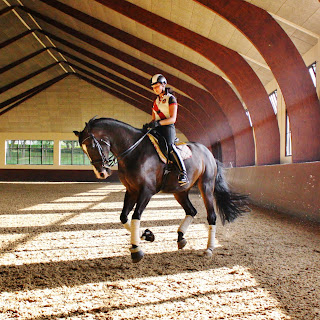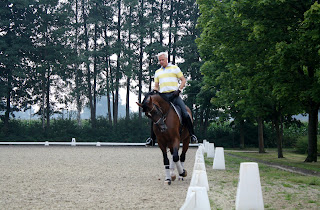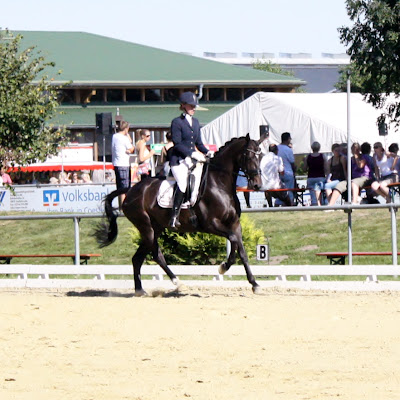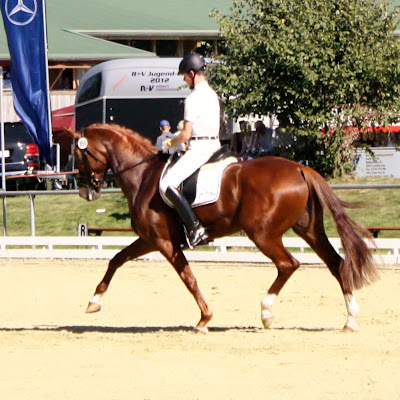 |
| (Left to right: Nicole DelGiorno, Jaclyn Pepper, Matthias Rath, Jenna Detandt, Catherine Chamberlain) |
 After all the introductions had been made, he told us a
little bit about the horse that were being worked. Then we watched him ride a
young mare. After watching him for a few minutes, there was no question about
what a phenomenal rider he is. Everything that he did was very quiet and it was
nearly impossible to see his aids. For the next horse, we went to the outside
ring which was gorgeous. We sat at an old stone table by “C”. The horse’s name
was “Bretton Woods”, a very well known stallion. To say that the gorgeous
7-year-old stallion was a little hot would be a bit of an understatement. It
was very interesting to watch how Matthias rode through it. He was always very
fair, and never over corrected Bretton Woods. Several times the stallion tried
to spook and run away, but Matthias was right there with him and kept the
stallion together. He never made a big deal out of it; he just gave the horse a
firm kick and told him to get over it.
After all the introductions had been made, he told us a
little bit about the horse that were being worked. Then we watched him ride a
young mare. After watching him for a few minutes, there was no question about
what a phenomenal rider he is. Everything that he did was very quiet and it was
nearly impossible to see his aids. For the next horse, we went to the outside
ring which was gorgeous. We sat at an old stone table by “C”. The horse’s name
was “Bretton Woods”, a very well known stallion. To say that the gorgeous
7-year-old stallion was a little hot would be a bit of an understatement. It
was very interesting to watch how Matthias rode through it. He was always very
fair, and never over corrected Bretton Woods. Several times the stallion tried
to spook and run away, but Matthias was right there with him and kept the
stallion together. He never made a big deal out of it; he just gave the horse a
firm kick and told him to get over it.  We had the opportunity to watch several other riders that
morning, including Anne-Kathrin Linsenhoff who is an Olympic Gold Medalist. She
is such a lovely rider, and you can see the partnership she has with her
horses. In fact, all of the riders at Schafhof were exceptional. They were
extremely quiet riders, and yet still very effective. The horses went through
their workouts with ease. However, they were not at all robotic, they were
still horses and it was fun to see each of their individual personalities.
We had the opportunity to watch several other riders that
morning, including Anne-Kathrin Linsenhoff who is an Olympic Gold Medalist. She
is such a lovely rider, and you can see the partnership she has with her
horses. In fact, all of the riders at Schafhof were exceptional. They were
extremely quiet riders, and yet still very effective. The horses went through
their workouts with ease. However, they were not at all robotic, they were
still horses and it was fun to see each of their individual personalities.  Matthias spent a lot of time warming the horse up in a low
frame. He would keep the horse slightly behind the vertical, for obvious
submission reasons. However, the horse wasn’t restricted in the neck or cranked
up. The back was always swinging and the neck was always forward. It was very
apparent that the horse was being ridden over the back. Then, when the stallion
began to stretch even more to the bit, he would bring him a little in front of
the vertical. Matthias explained that the stallion had been shown in a lot of
stallion shows before his family bought him. He said that how the stallions are
trained for that is very different from how dressage horses should be train. In
the stallion shows, the horses are expected to go around the ring with a very
high frame, and that their gaits are pushed to the maximum. This creates a lot
of stiffness in the back of the horse, and also teaches them to lean on the
rider.
Matthias spent a lot of time warming the horse up in a low
frame. He would keep the horse slightly behind the vertical, for obvious
submission reasons. However, the horse wasn’t restricted in the neck or cranked
up. The back was always swinging and the neck was always forward. It was very
apparent that the horse was being ridden over the back. Then, when the stallion
began to stretch even more to the bit, he would bring him a little in front of
the vertical. Matthias explained that the stallion had been shown in a lot of
stallion shows before his family bought him. He said that how the stallions are
trained for that is very different from how dressage horses should be train. In
the stallion shows, the horses are expected to go around the ring with a very
high frame, and that their gaits are pushed to the maximum. This creates a lot
of stiffness in the back of the horse, and also teaches them to lean on the
rider.
Then Matthias gave us a tour of Schafhof. It certainly was
one of the most impressive places that I have ever been to. Somewhere around 50
horses are on the farm, with approximately 30 horses being under saddle. The
other horses are broodmares, foals or retired horses. It was incredible to see
all of the history his family has in dressage.
 After we had watched
most of the horses work, Klaus Martin and Ann-Katrin were kind enough to ask if
we had anything we wanted to know. I asked Klaus Martin if he had any advice to
give to us as young riders about what our focus should be—what we should
remember as we continue in our dressage training. He replied that he believed
that there were many answers, but that he really believed it was important to
learn how to tune into every horse that you have the opportunity to work with. He
said that it was a very important characteristic that you must have as a rider.
After we had watched
most of the horses work, Klaus Martin and Ann-Katrin were kind enough to ask if
we had anything we wanted to know. I asked Klaus Martin if he had any advice to
give to us as young riders about what our focus should be—what we should
remember as we continue in our dressage training. He replied that he believed
that there were many answers, but that he really believed it was important to
learn how to tune into every horse that you have the opportunity to work with. He
said that it was a very important characteristic that you must have as a rider.
Since the purpose behind this trip was to go and observe
training in one of the best dressage countries, I thought it would be
informative to get Ann-Kathrin’s summery of why Germany is so successful in
dressage. She said that her belief is that the tradition is strong in Germany,
but there is also a strong commitment to proper training and teaching. Another quality
that she believes makes Germany so successful is the German mindset which hold
a very high standard in everything that they do.

The best was saved for last, and we were finally able to meet Totilas! He is so gorgeous and so well behaved! It was a dream come true to stand next to him, none of us wanted to leave. After a couple of pictures, we said our goodbyes to one of the greatest dressage horses of all time! Matthias was kind enough to give us each a Totilas fan shirt. Mine says “Totilas My No. 1!”

The best was saved for last, and we were finally able to meet Totilas! He is so gorgeous and so well behaved! It was a dream come true to stand next to him, none of us wanted to leave. After a couple of pictures, we said our goodbyes to one of the greatest dressage horses of all time! Matthias was kind enough to give us each a Totilas fan shirt. Mine says “Totilas My No. 1!”
















































